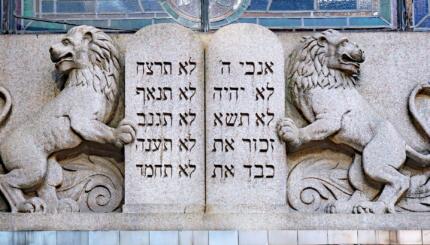For more about Jewish parenting, visit our partner site, Kveller.
Why do we need ceremonies at all to welcome Jewish babies? A baby born to a Jewish mother (or in Reform and Reconstructionist communities, to a Jewish father) or who is converted to Judaism is a Jewish baby, period. What is the purpose of a ceremony of welcome, of covenant, of naming?
Purposes of Ceremonies for Babies
Such ceremonies and their rituals serve many purposes. They initiate a lifetime of marking significant events in the context of tradition and community functions. They represent the fulfillment of mitzvot, of commandments or obligations, that require such ceremonies. They help us to avoid what Rabbi Harold Schulweis calls “rite-less passages” — moments of significance that simply happen, without notice or celebration. They link us to the Jewish past and commit us to a Jewish future. They serve as an opportunity to reinforce central beliefs and symbols–for example, covenant, commandment, and community — that characterize Judaism and Jewish life.
Perhaps most significantly, as Rabbi Laura Geller notes, they effect transformation. Before a brit milah (covenantal circumcision ceremony) or a brit bat (covenant ceremony for girls, also known as “simchat bat”), a baby is simply the child of particular parents — even referred to only as “the baby.” After such a ceremony, she becomes herself, he becomes himself, in Geller’s words, “a Jew linked through ritual to covenant and messiah, and transformed through ritual into so-and-so [the child of] particular parents within the context of the Jewish people.…The infant is transformed, named, given tribe and history, roots and purpose, baggage and wings” (Lifecycles, Vol. I, ed. Rabbi Debra Orenstein, pp. 61-62). The community too is changed, having once again engaged with our history and our future, and having welcomed another member into our midst.
With your help, My Jewish Learning can provide endless opportunities for learning, connection and discovery.
Traditional Jewish sources can illuminate particular subjects such as:
· Why circumcision is necessary to “perfect” nature, and why it is such a significant commandment;
· The religious significance of building a family; and
· The historical basis of practices such as the use of water in ceremonies for girls and the planting of trees at the birth of a child.
Adoption
Adoption represents a special case in the larger context of welcoming new Jewish babies, with two additional sets of issues. First, a child who was not Jewish at birth needs to be converted to Judaism. His brit milah or her brit bat may incorporate part of what is necessary to make this baby Jewish (e.g., circumcision is in most communities required to convert a Jewish boy), but the additional requirement of immersion in a mikveh (ritual bath) for converts of any age is usually practiced as well. Second, while there is no Jewish ritual for adoption — indeed, adoption has no special history in Jewish law or custom — many Jewish adoptive parents wish to find ways to mark Jewishly this particular way of expanding their family. Special readings or rituals may be added to the baby’s ceremony, or families may wish to find other ways to mark this event in the context of community, e.g., with an aliyah to the Torah or a party for their congregation.
Naming
Where a brit milah or brit bat takes place, the child’s Hebrew name is formally announced and given (according to traditional custom, for the first time) during that ceremony. Sometimes, a girl will simply be “named” during the Torah service of morning services (often on Shabbat), either in lieu of a brit bat or before it is scheduled.
While popular wisdom suggests that “Jews name children for dead relatives,” the reality is much more expansive. The custom of naming a baby after a deceased family member is the practice only among Ashkenazic Jews; Sephardic Jews often honor living relatives by naming a child after them. In addition, there are many other traditions and inspirations governing the naming of Jewish children, including using biblical names, names popular in modern Israel, and names associated with a holiday or Torah reading near the child’s birth. Many parents give their child a “secular name” (which appears on the birth certificate and may be used in non-Jewish contexts) and a “Hebrew name” (which for Ashkenazic Jews may also be Yiddish names. They may also be called Jewish baby names). Others prefer to give their child a Hebrew name by which they may comfortably be known in all aspects of their life.
Guide for Guests
Welcome ceremonies for Jewish babies can vary a lot from community to community and from family to family, so it’s hard to say exactly what a guest should expect. A bris or brit bat might take place in a synagogue, or another public space like a community center, or it can be held at the new baby’s home.
When a bris is at a synagogue, it often immediately follows morning prayer services. These services last about 30 minutes on a weekday, and significantly longer on Shabbat (again, this varies from synagogue to synagogue). In some communities it might be appropriate for guests who are unfamiliar with Jewish prayer to arrive near the end of services, just in time for the bris ceremony itself. This is something guests can ask their hosts to clarify in advance.
If a bris or brit bat is not planned as part of a prayer service, it is appropriate to arrive on time. It is likely that the ceremony will take place first, followed by a festive meal.
In most cases it’s nice to bring a gift. This can be a standard baby present such as clothes, toys, books, or money. Gifts can be Jewishly-themed or not. Some families might appreciate a donation to charity in honor of their baby. There is also a tradition of planting a tree in Israel in honor of a birth.
For more about Jewish parenting, visit our partner site, Kveller.
bris
Pronounced: briss, Origin: Yiddish, Jewish circumcision ceremony for an 8-day-old boy, marking the covenant between God and the Jews. This term is short (and uses the Yiddish pronunciation) for brit milah, which means covenant of circumcision.
brit bat
Pronounced: breet BAHT, Origin: Hebrew, literally "daughter's covenant," this is a Jewish naming ceremony, or welcoming ceremony, for a newborn girl.
brit milah
Pronounced: breet mee-LAH, Origin: Hebrew, literally "covenant of circumcision," the Jewish circumcision ceremony for an 8-day-old boy, marking the covenant between God and the Jews. Also known as a bris.
Sephardic
Pronounced: seh-FAR-dik, Origin: Hebrew, describing Jews descending from the Jews of Spain.
Torah
Pronunced: TORE-uh, Origin: Hebrew, the Five Books of Moses.


